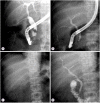An Update on Endoscopic Management of Post-Liver Transplant Biliary Complications
- PMID: 28415168
- PMCID: PMC5642064
- DOI: 10.5946/ce.2016.139
An Update on Endoscopic Management of Post-Liver Transplant Biliary Complications
Abstract
Biliary complications are the most common post-liver transplant (LT) complications with an incidence of 15%-45%. Furthermore, such complications are reported more frequently in patients who undergo a living-donor LT compared to a deceased-donor LT. Most post-LT biliary complications involve biliary strictures, bile leakage, and biliary stones, although many rarer events, such as hemobilia and foreign bodies, contribute to a long list of related conditions. Endoscopic treatment of post-LT biliary complications has evolved rapidly, with new and effective tools improving both outcomes and success rates; in fact, the latter now consistently reach up to 80%. In this regard, conventional endoscopic retrograde cholangiopancreatography remains the preferred initial treatment. However, percutaneous transhepatic cholangioscopy is now central to the management of endoscopy-resistant cases involving complex hilar or multiple strictures with associated stones. Many additional endoscopic tools and techniques-such as the rendezvous method, magnetic compression anastomosis , and peroral cholangioscopy-combined with modified biliary stents have significantly improved the success rate of endoscopic management. Here, we review the current status of endoscopic treatment of post-LT biliary complications and discuss conventional as well as the aforementioned new tools and techniques.
Keywords: Anastomotic leak; Biliary tract diseases; Cholangiopancreatography, endoscopic retrograde; Choledocholithiasis; Liver transplantation.
Conflict of interest statement
Figures







References
-
- Balderramo D, Navasa M, Cardenas A. Current management of biliary complications after liver transplantation: emphasis on endoscopic therapy. Gastroenterol Hepatol. 2011;34:107–115. - PubMed
-
- Brown RS, Jr, Russo MW, Lai M, et al. A survey of liver transplantation from living adult donors in the United States. N Engl J Med. 2003;348:818–825. - PubMed
-
- Akamatsu N, Sugawara Y, Hashimoto D. Biliary reconstruction, its complications and management of biliary complications after adult liver transplantation: a systematic review of the incidence, risk factors and outcome. Transpl Int. 2011;24:379–392. - PubMed
Publication types
LinkOut - more resources
Full Text Sources
Other Literature Sources

